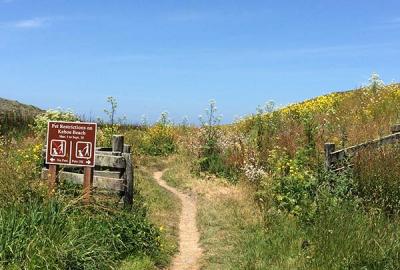Nature Notes: View From California

Here I am in San Francisco after a two-year hiatus. Things keep changing, but at the same time keep staying the same. The beautiful houses dating back to the 1920s in the hilly neighborhoods are in fine dander. The streets are clean. People walk and jog back and forth as much as they ride in motor vehicles. The sun comes out and disappears behind low-lying fog clouds just as you are beginning to warm up a bit.
It’s a city, but about as wild as a large civilized municipality can be. Raccoons, opossums, skunks, and gophers use the backyards as much as the humans do. Crows, mockingbirds, pigeons, house finches, jays, and a host of different sparrows perch, fly, call, and generally live it up just as they do in the wild and suburbs. Coyotes prowl the canyons and arroyos where there are few houses. Red-tailed and red-shouldered hawks make lazy circles in the sky alternating with turkey vultures.
One California wildlife species that is missing is the cougar, but only by a few miles or so. Go across the Golden Gate Bridge and you are in Marin County, where mountain lions are not uncommon. Drive south along the Pacific Coast Highway to Daly City, Half Moon Bay, and beyond and you might bump into one.
Environmental awareness is big here, as big as it is on eastern Long Island. Water, or the lack of it, is the major topic of the moment. Two years of drought has threatened to bring the Golden State to its knees. Northern and mid-coastal California are doing their parts to conserve. Two ritzy places, Montecito, near Santa Barbara, and Hillsborough, south of San Francisco, have cut water use by as much as 75 percent, while the upscale municipalities around Los Angeles and San Diego continue to guzzle water in nearly the same amounts as before the drought.
There are a lot of rehab projects going on in the Bay Area. To the north next to Tomales Bay almost 100 acres of flat farmland was purchased by the state and returned to tidal wetlands two years ago. The bar blocking the tides was removed, the land became flooded and, just as Long Island’s own ecological restoration expert, Karen Blumer, would have predicted, the coastal plain remnant returned to its former self on its own. The seeds and other native marsh plant propagules were still there and more came in with the tides. Now it is thriving with herons, egrets, marsh birds, and the like.
I visited the famous Presidio with my son and daughter-in-law on Saturday. The Presidio was once a very large military base on the shore of San Francisco Bay across from Alcatraz, but before that it was a Spanish fort and a large cattle ranch overseen by a woman rancher in the 1800s. There was a spring that satisfied the cattle’s needs, but it fell into disrepair during the United States military occupation, which lasted into the early 1990s. Now the spring has been rediscovered and protected as a historic landmark while the shore along the bay and the tidal flats next to it have been totally recovered.
The ocean on the other side of the bridge, a stone’s throw away, has become the Farallones National Marine Sanctuary, the third such large sea sanctuary along the California coast from the Santa Barbara Channel to north of San Francisco. Like the others, it’s a sanctuary for marine mammals, but recreational and commercial fishing goes on as in the past under the watchful eye of the California Fish and Game Commission. But you will not find any drilling for oil or wind turbines in the sanctuary. We should have one like it along the Long Island and New England coast. Fishing, yes; energy mining and wind towers, no!
It is heartening to see that the environmental movement is as prominent here as it is on eastern Long Island and upstate New York. There is a 75-percent chance of an El Nino in the Pacific in the near future, which would bring needed precipitation to the state. But then again, continued global warming would make the climate drought-prone, so in the long run it is a crapshoot at best. Landscaping with succulent, drought-resistant plants is one adaptive measure taking place on a wide scale. Water conservation is coming of age, but fracking and oil drilling, two major polluters of groundwater — the second most important source of fresh water here — are still rampant.
And, oh yes, solar is big here, as it is becoming big everywhere across the United States, and that is very encouraging.
I started my environmentalism in California in the 1960s. It’s heartening to see that the movement here is as strong as ever, perhaps even stronger.
Larry Penny can be reached via email at [email protected].
